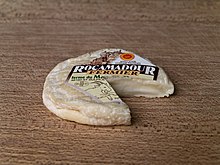 | ||
| Rocamadour | ||
| Department | Lot | |
|---|---|---|
| Residents | 611 (2018) | |
| height | 279 m | |
| Tourist info web | www.rocamadour.com | |
| no tourist info on Wikidata: | ||
| location | ||
| ||
Rocamadour is a city in the department Lot in the French region Midi-Pyrénées. The name is derived from Saint Amadour, who stands at the foot of a steep rock (French Roc) lived as a hermit. The place is divided into three levels. The lower level is the actual place with the houses from the Middle Ages. On the middle level are the seven churches of the pilgrimage site and on the upper level is a castle from the 14th century.
background
Rocamadour was first mentioned in a charter in 968, when the area around the city was given to the Benedictines of Grommet was given. In 1166 an undecayed corpse was found in a grave near the Marienkapelle and it was believed to be Saint Amadour. Shortly afterwards, the first miracles were recorded by the Benedictines, whereupon the place developed into a place of pilgrimage. In the Lady Chapel is the Black Madonna, the destination of pilgrims who come to Rocamadour. The place is on the pilgrimage route to Santiago de Compostela and is part of the UNESCO world cultural heritageCamino de Santiago in France.
With 1.5 million tourists a year, Rocamadour is the fifth most visited attraction in France (after Mont-Saint-Michel, the old town of Carcassonne, the Eiffel Tower and the Palace of Versailles).
getting there
By plane
Closest international airport is Toulouse-Blagnac. From there it is approx. 165 km to Rocamadour (approx. 1:45 hours by car). The airport is a little closer, but much smaller Rodez-Aveyron (105 km; 1:35 hours). You can also arrive via the airport Limoges (165 km; 1:45 hours) should be considered.
By train
The Rocamadour / Padirac train station is just 5 km northeast of the town center. Regional express trains (TER) from Brive-la-Gaillarde (journey time 40 minutes) and Rodez (1:45 hours) stop there seven times a day. Coming from Paris, you have to change in Brive-la-Gaillarde (a total of 5:20 hours from Gare d’Austerlitz), coming from Toulouse in Figeac (a total of 3 hours). There is a continuous night train from Paris once a day.
By bus
In the street
Rocamadour is close to the A 20 (Paris – Toulouse) motorway, which can be accessed from the north at junction number 54 Gouffre de Padirac / Gramat / Rocamadour leaves (31 km from there), coming from the south at № 56 Aurillac / Sarlat / Figeac (another 25 km). From Limoges it is 145 km, which takes a good 1½ hours, from Toulouse 170 km (2 hours), from Paris 530 km (5:15 hours).
By boat
On foot
The GR 6 long-distance hiking trail leads through Rocamadour Sainte-Foy-la-Grande (Gironde) to Saint-Paul-sur-Ubaye on the French-Italian border in the Alps; the GR 46 from Toulouse to Tours; as well as a side branch of the Camino de Santiago from Clermont-Ferrand to Cahors.
mobility
Tourist Attractions


- Cité réligieuse
- Saint-Amadour crypt
- Saint Sauveur basilica
- Saint-Jean-Baptiste Chapel
- Saint Blaise Chapel
- Chapel of Sainte-Anne
- Notre-Dame chapel. With altar of the Black Madonna.
- Saint-Michel chapel
- Saint-Louis Chapel
- Holy way. Staircase with 216 steps and church forecourt.

- City gates
- Musée d'art sacré Francis Poulenc. Museum of Sacred Art.
- La maison des abeilles. Bee and beekeeping museum.
- Rocher des Aigles. Falconry.
- Grotto des Merveilles. Cave with paleolithic paintings in the district of L’Hospitalet, 1 km northeast of the town center.
- Grotte de Linars. Stalactite cave and burial site from the late Bronze Age, approx. 1000 BC Chr .; 1.5 km east of the town center.
activities
shop
kitchen

The best-known product from Rocamadour is the goat cheese of the same name.
nightlife
accommodation
health
Practical advice
trips

- Gouffre de Padirac. Gullet of Padirac; 16 km northeast. Karst cave system created by an underground river.
- Carennac. 20 km northeast. Late medieval fortified village that was named one of the most beautiful villages in France.
- Martel. 20 km north. High medieval Palace de la Raymondie with belfry, partly redesigned during the Renaissance, museum with Gallo-Roman excavations of the Celtic city of Uxellodunum; Market hall made of chestnut wood from the 18th century.
- Souillac. 22 km northwest. Romanesque abbey church, castle-like church Saint-Martin, historic market hall from the 1830s (classicistic).
- Viaduc de la Borrèze near Souillac. 25 km northwest. 30-arched and approx. 570 meter long brick railway bridge (built 1881–85).
- Château de Castelnau Bretenoux in Prudhomat. 27 km northeast. Most impressive medieval fortress in the Quercy.
- Bretenoux. 28 km northeast. Old town with half-timbered houses and market.
- Gourdon. 30 km southwest. Saint-Pierre gothic church, historic town hall.
- Assier. 33 km southeast. Renaissance castle and renaissance church Saint-Pierre.
- Figeac. 45 km southeast, 35 minutes by train. City of art and history with a medieval old town; Birthplace of the Egyptologist Jean-François Champollion, who succeeded in deciphering the Rosetta Stone.

